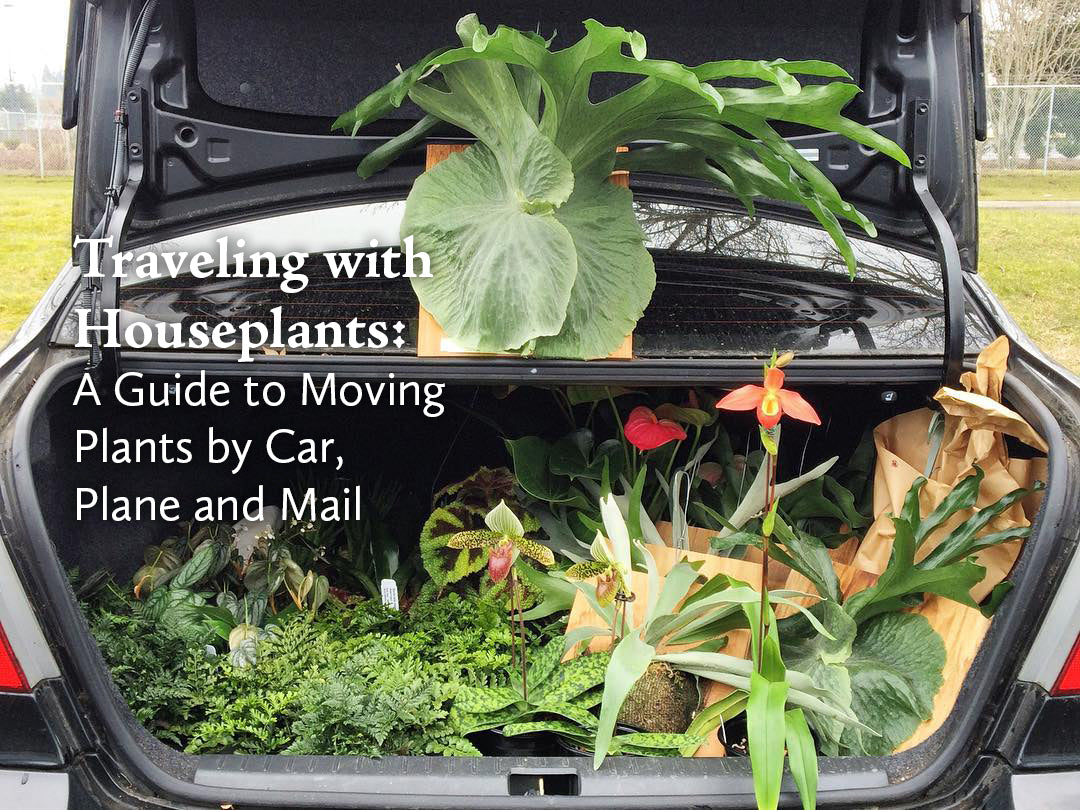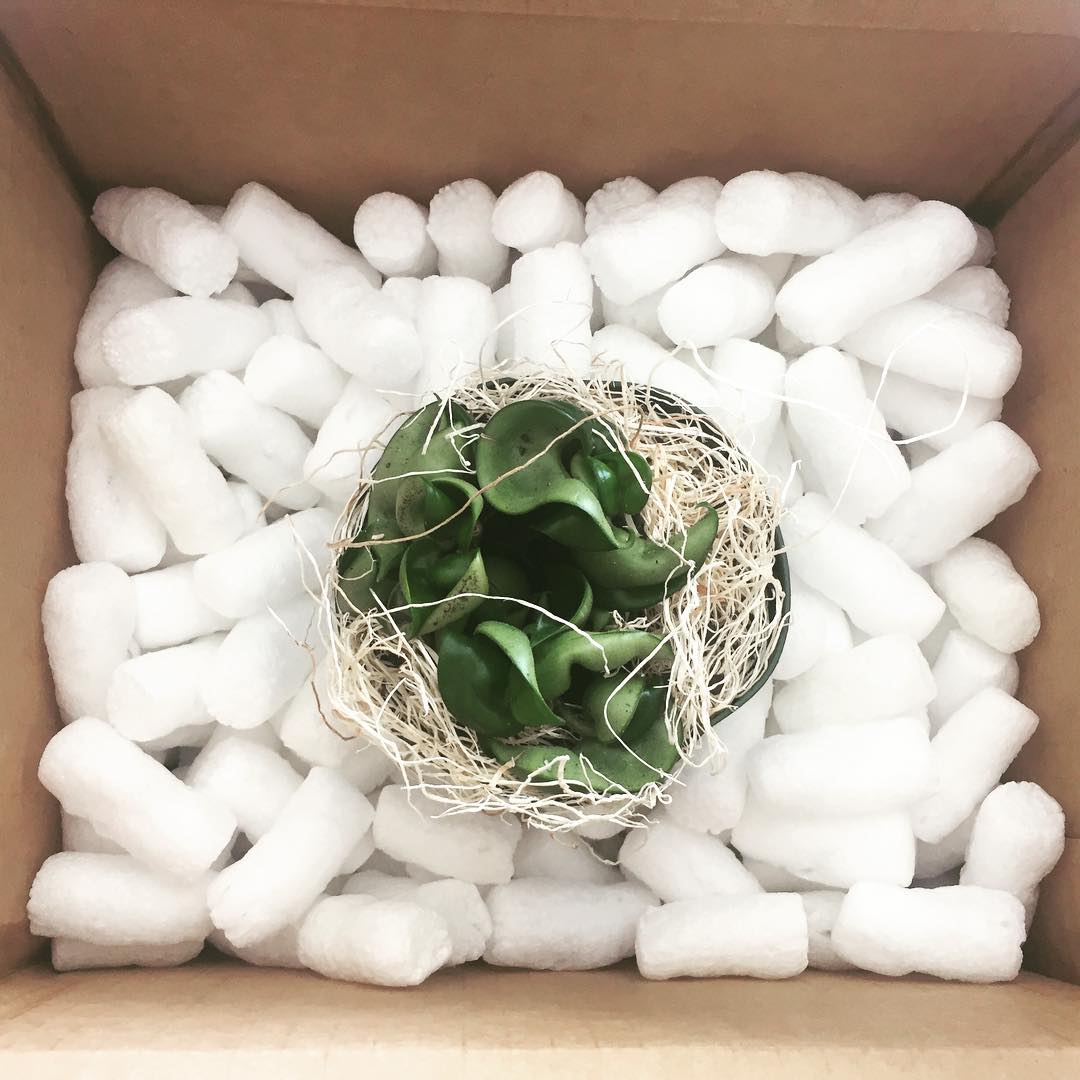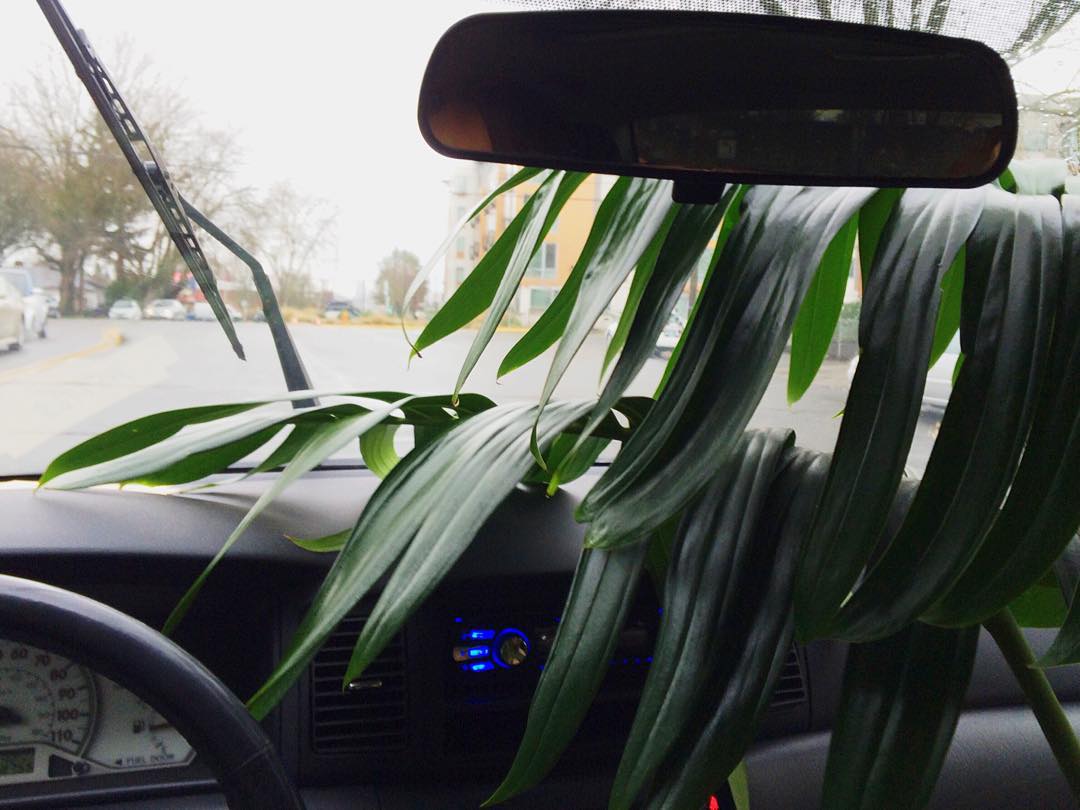Sometimes, as plant people, we are faced with the rather delicate task of traveling with houseplants. Maybe you want to bring all those stray propagations you’ve started along as gifts for the holidays. Maybe you need to move to a new state with your collection. Or maybe while traveling, you stop by a little nursery for a “quick peek” and find yourself face to face with the Philodendron of your dreams.
In any case, here are some helpful tips for keeping your plants safe and sound on their journey, whether you’re moving or giving plants as gifts.

Traveling with Houseplants
Preparing Plants for Travel
A week or two before you plan to be traveling with houseplants, it’s prudent to give them a little care to get them in good shape for the environmental fluctuations they will encounter on their journey. Plants have busy lives looking for things that nourish and fulfill just like we do, but they go about their business much more slowly, requiring patience and a light touch from their keepers. Always give ample time between big changes to allow your plant a chance to get its bearings. Too much change or stimulation at once can stress a plant, causing stunted or halted growth, leaf loss, and susceptibility to problems such as pests and infections.
To prepare for traveling with houseplants, begin by preening and pruning a bit. Remove any dead or damaged leaves. If your plant has long vines or stems that are particularly meandering, you can trim these back to make travel more manageable. Consider repotting plants in plastic nursery pots to cut weight and reduce the risk of breaking pottery. Gently dust foliage with a dampened cloth (or soft paint brush for hairy or velvety foliage) and treat for pests if necessary.
You can water very thirsty specimens such as ferns the day before the journey (or early morning the same day if it’s hot out). Water more moderate plants a few days before so that soil is lightly moist but not wet during travel. Remember that wet soil in a dark, cool place poses a high risk of root rot.
Traveling with Houseplants in the Car
If traveling with houseplants feels daunting to you, it may be helpful to know that it’s a lot like traveling with animals. You’ll want to keep your car warm on cold days and cool on hot days (see below for more details about how temperature affects travelling with houseplants).
If you have to leave your plants in the car on a hot day, treat them as you would a dog. Park in the shade, crack the window, and don’t dawdle returning from your errand. A shower curtain or tarp will protect your car from dirt and moisture, if you are concerned about cleanliness. Bring along extra newspaper, paper towels, and a watering can or water bottle.

This Ficus Lyrata is about to make a decidedly unsafe journey. Best to only travel with plants you can fit!
The safest way to pack your plants is to use sturdy boxes. Arrange boxes on the floor or on seats (not the trunk or open truck bed) so that they are as stable as possible. You can nestle plants inside of these, taking care to lift and gentle spool any loose vines on top. Cut air holes if you plan to keep them covered and pack pots loosely with newspaper. If it’s a particularly hot day, you can use lightly dampened newspaper or sphagnum moss to pack the pots in order to keep plants cool and humid in your car’s warm, dry interior.
You can buckle in particularly big specimens and place large pots in garbage bags to avoid spillage, but make sure to keep the bag slightly open at the top to let the soil breathe. A bird cage, dog crate, or cat carrier can be helpful for particularly delicate or prized specimens. A sheer cloth draped over these structures will protect from harsh light.
Ideally, your plants will be exposed to light every day, but are vulnerable to sunburn on a hot backseat. Keep boxes covered unless the weather is consistently overcast. Rest stops are a good time to find a parking spot with bright, indirect light to stop and take the lid off.
On longer trips, make sure you bring plants inside with you at night. One night in a cold car is easily enough to severely damage or kill a tropical plant. Water plants sparingly in hotel sinks or bathtubs if they dry out. If it’s a very long trip and they must be kept covered during the day, you can leave them in a hotel tub with the bathroom light (or a grow light brought from home) left on overnight to help make up the difference.

Seatbelts can help plants stay in place on drives, just as they do their human co-pilots!
Always remember to check with each state’s particular restrictions beforehand if you are moving your collection across state lines. Some states known to have tighter regulations are California, Arizona, and Florida. If you’re traveling into Canada, you might not be legally allowed to bring your plants with you. Make sure to brush up on current rules and regulations around declaring plant material here.
Traveling with Houseplants on Planes
Although each airline makes its own policy, in most situations houseplants are welcome in your carry-on or checked bags as long as they comply with baggage rules. However when bringing houseplants on a plane, you should be prepared to unpack plants for inspection and to send them through the x-ray along with the rest of your items.
Wrap the pot or entire plant in a plastic bag to avoid soil spillage or to be extra safe, consider keeping plants “bare root” (in some situations, this may be legally required as soil can harbor foreign insects). To do this, ease your plant out of its pot, tease any excess soil off with your fingers, and gently rinse roots in lukewarm water to remove the rest. Swaddle the roots in damp moss or paper towels for the journey and repot promptly when you reach your destination.
In most cases, traveling with houseplants in the contiguous U.S. won’t be a problem, but overseas or international trips can get a bit trickier. National agricultural departments often have strict rules about which plants are allowed across borders. It’s important to respect these rules because even one invasive plant or insect can have a lasting and detrimental effect on delicate ecosystems and agricultural economies.
Some locations in the US like Hawaii and Puerto Rico have strict agricultural restrictions. Though some live plants can be brought in, most will need to be bare rooted and some can be invasive. Always research the rules and regulations of your departure and destination points before you plan to travel with plants across national (and some state) borders. You can contact your destination country’s department of agriculture to find out about potential fees and permits. Check the U.S. Customs & Border Protection website for more info.
Sending Houseplants in the Mail
What if you just want to send plants to family and friends, but aren’t making the journey yourself? We don’t blame you — plants make great gifts. Here are a few tips for shipping houseplants in the mail
- For simplicity, only ship plants in their plastic nursery pots, or consider shipping bare root (see above for instructions). Water a day or two before shipping, so that the soil is moist, but not sopping wet.
- Cover the soil around the base of the plant to prevent it from shifting and making a mess in the box. Taping newspaper tends to work well!
- Create a sleeve around the plant by rolling it in butcher paper or newspaper. It helps to lay the plant on its side or fully invert it before sleeving so that you can ensure foliage is not crumpled or bent during this process.
- Find a box that is only slightly larger than the plant you’re shipping. Place the plant inside, and insulate it with shredded newspaper, peanuts (we use the biodegradable kind), crumpled paper — anything to ensure that the plant cannot shift in transit. Before sealing the box, give it a gentle shake. Do you hear the plant shifting inside? You should go back and add more insulating material. If you’re shipping multiple plants in the same box, these same rules apply.
- During winter, your plant can freeze in transit. We use heat packs in our shipments. Likewise, avoid shipping during heat waves, and always let the recipient know when to expect their box so it doesn’t sit out on a hot or cold porch.
- We recommend USPS Priority for shipping houseplants in the mail, as it’s a max of 3 days in transit. Always label your box “contains live plants” so that mail carriers know to treat the box with care, and for states like California that have agricultural restrictions.

Image of Pistils Nursery plant by @suburbansill
If sending plants in the mail sounds too risky to you (or like too much work!), we should note that we’ve just about got it honed it down to a science. If you’ve dreamed about visiting our shop but haven’t been able to make the trip, you can still visit our web shop and adopt a new plant which will be carefully packaged by dedicated plant people here in Portland, Oregon and shipped to your door.
A Word About Temperature
Beautiful yet delicate, tropical plants are able to live happily in our homes because their preferred temperatures are pretty close to our own (think “t-shirt weather” temps of between 65-75 F). Their evolution has not prepared them for a Missouri winter or a New Mexico summer.
This means that traveling with houseplants requires a gentle touch and a little forethought.
Cold is particularly hard on tropical plants. In winter, even a walk down a windy street or a wait for the bus on a snowy day can do permanent damage. Plan accordingly when buying these tender plants and get them home or into a warm environment as quickly as possible. Remember: If you’re cold, your tropical plant is probably cold too.
But what does it look like when a plant has suffered from temperature extremes? Cold damage usually manifests as sudden blackening or yellowing of leaves and new shoots. Leaves might feel cold to the touch and appear wilted but do not respond to water. Frozen plants will often get mushy leaves caused by cellular damage. If your plant suffers cold damage, put it in a warm, well-lit spot (a grow lamp is a good tool to keep in your houseplant first aid kit for calming stressed plants and coaxing new growth) and offer gentle, consistent care. Oftentimes a plant will lose some leaves due to shock but, as long as the roots have not been too severely damaged, begin to put out new ones again before too long.
Heat damage looks similar to cold damage. Plants are severely wilted, but soil is still damp or they do not recover when watered. Leaves may curl or turn crisp. Sunburn looks like your plant has been bleached of its rich color, turning suddenly pale. Sunburn damage can also look like pale to dark brown papery spots or leaf tips. Put overheated plants in a cool place with gentle light and provide gentle humidity (a humidifier, pebble tray, or mister) and more water if they’ve dried out. Clip any severely sunburned leaves; they will not recover.

What have your experiences traveling with houseplants taught you? Share with us in the comments!
